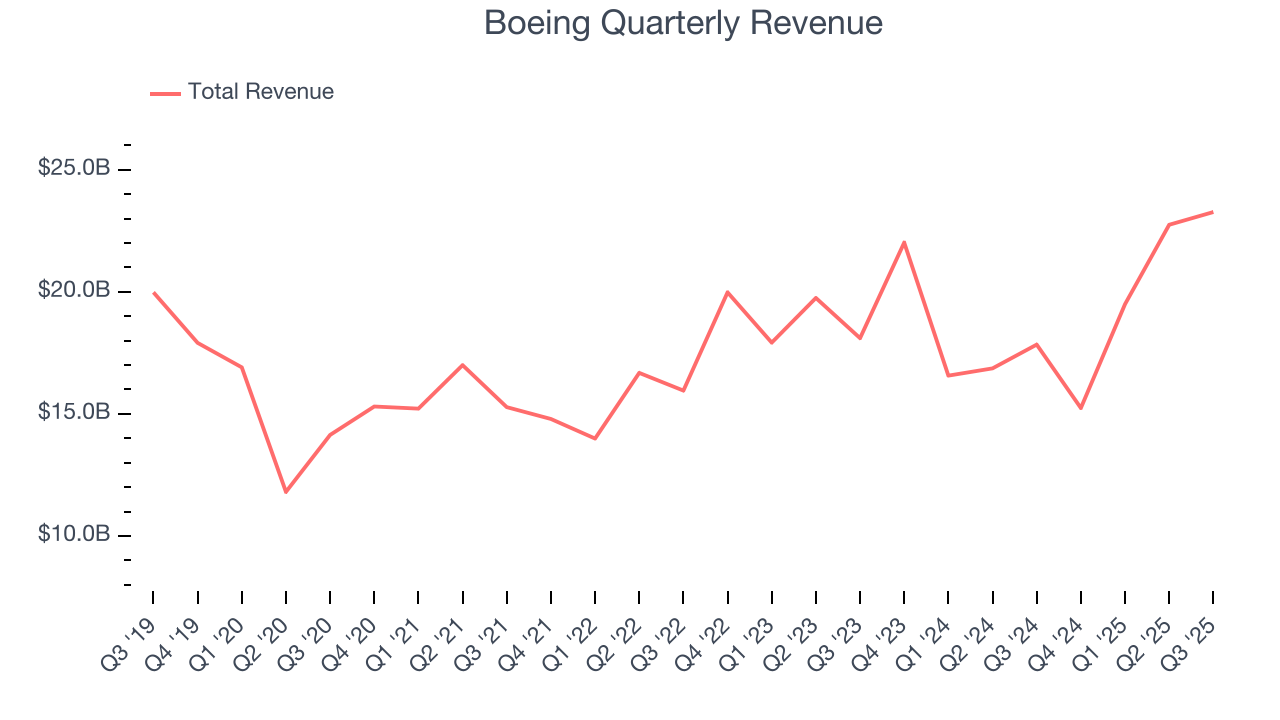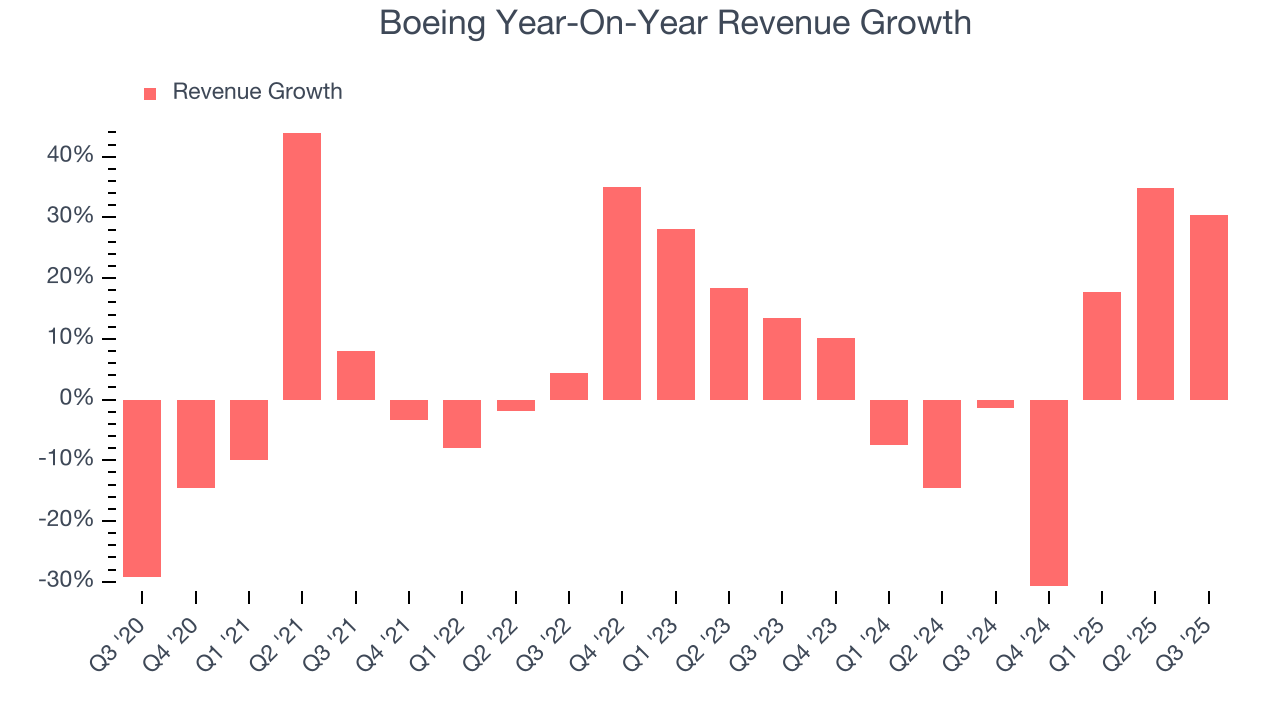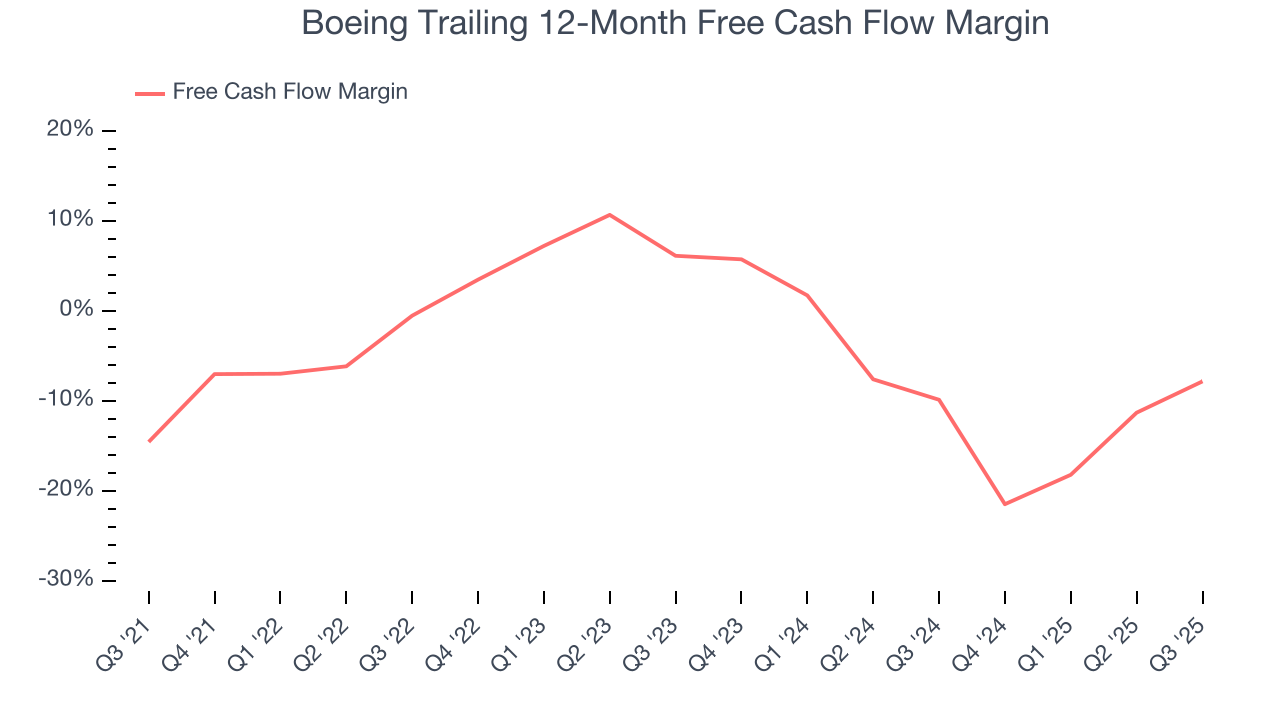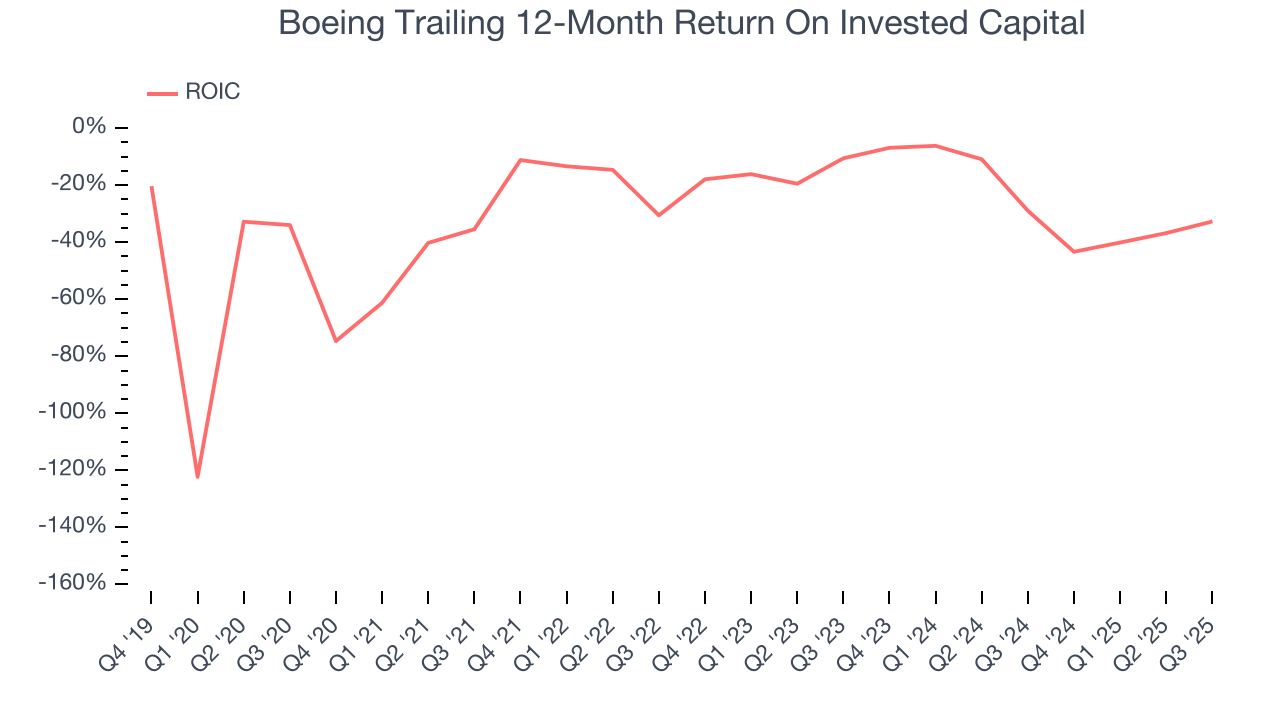
Boeing (BA)
We wouldn’t buy Boeing. Not only has its sales growth been weak but also its negative returns on capital show it destroyed value.― StockStory Analyst Team
1. News
2. Summary
Why We Think Boeing Will Underperform
One of the companies that forms a duopoly in the commercial aircraft market, Boeing (NYSE:BA) develops, manufactures, and services commercial airplanes, defense products, and space systems.
- Historically negative EPS raises concerns for risk-averse investors and makes its earnings potential harder to gauge
- Historical operating margin losses point to an inefficient cost structure
- EBITDA losses may force it to accept punitive lending terms or high-cost debt


Boeing’s quality isn’t great. There are more promising alternatives.
Why There Are Better Opportunities Than Boeing
Why There Are Better Opportunities Than Boeing
At $202.17 per share, Boeing trades at 288.5x forward P/E. We consider this valuation aggressive considering the weaker revenue growth profile.
We prefer to invest in similarly-priced but higher-quality companies with superior earnings growth.
3. Boeing (BA) Research Report: Q3 CY2025 Update
Aerospace and defense company Boeing (NYSE:BA) reported Q3 CY2025 results exceeding the market’s revenue expectations, with sales up 30.4% year on year to $23.27 billion. Its non-GAAP loss of $7.47 per share was significantly below analysts’ consensus estimates.
Boeing (BA) Q3 CY2025 Highlights:
- Revenue: $23.27 billion vs analyst estimates of $21.9 billion (30.4% year-on-year growth, 6.3% beat)
- Adjusted EPS: -$7.47 vs analyst estimates of -$2.38 (significant miss)
- Adjusted EBITDA: -$4.20 billion vs analyst estimates of -$560.1 million (-18.1% margin, significant miss)
- Operating Margin: -20.5%, up from -32.3% in the same quarter last year
- Free Cash Flow was $238 million, up from -$1.96 billion in the same quarter last year
- Backlog: $635.7 billion at quarter end
- Sales Volumes rose 37.9% year on year (10.5% in the same quarter last year)
- Market Capitalization: $168.9 billion
Company Overview
One of the companies that forms a duopoly in the commercial aircraft market, Boeing (NYSE:BA) develops, manufactures, and services commercial airplanes, defense products, and space systems.
Boeing began in 1916 when William Boeing founded Pacific Aero Products in Seattle, following his construction of the B&W seaplane. The company, renamed Boeing Airplane Company the following year, capitalized on the growing demand for military aircraft brought about by World War I, initially focusing on seaplanes. Over the decades, Boeing expanded its operations beyond military aircraft to become a leading producer of commercial jetliners. The company's aircraft designs and acquisitions of competitors and strategic partners, such as McDonnell Douglas in 1997, have played a crucial role in its growth. Boeing also ventured into space technology and advanced defense systems, marking significant diversification of its product lines.
Today, Boeing offers a range of products across its commercial and defense sectors. For the commercial market, Boeing designs and manufactures jet aircraft, including the 737 narrow-body and the 767, 777, and 787 wide-body models. These models are used by many well-known airlines such as Delta and American Airlines. If you’ve flown recently, there's a good chance you were in a Boeing model.
For the defense, space & security sector, Boeing produces manned and unmanned military aircraft and systems, including fighters, rotorcraft, and surveillance systems, alongside space and satellite technologies. Additionally, to complement its products the company offers support services, including maintenance, logistics, and data analytics, to both commercial and defense customers globally. These services provide aftermarket revenue for the company.
In terms of contracting, Boeing engages in both fixed-price and cost-type contracts. Fixed-price contracts, where the payment does not change regardless of the actual costs incurred, are common within the company, particularly in its defense segments. This contract type often applies to products and services with well-defined specifications, allowing Boeing to manage financial risks effectively. Conversely, cost-type contracts are used for projects that involve significant development and technical challenges, such as new aircraft designs or advanced defense systems. These contracts ensure Boeing is reimbursed for all allowable expenses to a set limit plus additional payment to allow for a profit, which is crucial for projects with high degrees of uncertainty and complexity.
Boeing also earns a significant portion of its revenue from U.S. government contracts, including those for the Department of Defense and other federal agencies. These contracts may involve Foreign Military Sales (FMS), where Boeing supplies military equipment and services to foreign countries with the U.S. government acting as an intermediary.
4. Aerospace
Aerospace companies often possess technical expertise and have made significant capital investments to produce complex products. It is an industry where innovation is important, and lately, emissions and automation are in focus, so companies that boast advances in these areas can take market share. On the other hand, demand for aerospace products can ebb and flow with economic cycles and geopolitical tensions, which can be particularly painful for companies with high fixed costs.
Boeing’s primary competitor is Airbus (OTC:EADSY), while other competitors in the aerospace industry include Lockheed Martin (NYSE:LMT), and Northrop Grumman (NYSE:NOC).
5. Revenue Growth
Examining a company’s long-term performance can provide clues about its quality. Any business can experience short-term success, but top-performing ones enjoy sustained growth for years. Regrettably, Boeing’s sales grew at a tepid 5.9% compounded annual growth rate over the last five years. This was below our standard for the industrials sector and is a rough starting point for our analysis.

We at StockStory place the most emphasis on long-term growth, but within industrials, a half-decade historical view may miss cycles, industry trends, or a company capitalizing on catalysts such as a new contract win or a successful product line. Boeing’s recent performance shows its demand has slowed as its annualized revenue growth of 3.2% over the last two years was below its five-year trend. 
We can dig further into the company’s revenue dynamics by analyzing its number of units sold, which reached 160 in the latest quarter. Over the last two years, Boeing’s units sold averaged 4.9% year-on-year growth. Because this number is better than its revenue growth, we can see the company’s average selling price decreased. 
This quarter, Boeing reported wonderful year-on-year revenue growth of 30.4%, and its $23.27 billion of revenue exceeded Wall Street’s estimates by 6.3%.
Looking ahead, sell-side analysts expect revenue to grow 15.2% over the next 12 months, an improvement versus the last two years. This projection is eye-popping for a company of its scale and indicates its newer products and services will catalyze better top-line performance.
6. Operating Margin
Boeing’s operating margin might fluctuated slightly over the last 12 months but has remained more or less the same, averaging negative 8.6% over the last five years. Unprofitable industrials companies that fail to improve their losses or grow sales rapidly deserve extra scrutiny. For the time being, it’s unclear if Boeing’s business model is sustainable.
Looking at the trend in its profitability, Boeing’s operating margin might fluctuated slightly but has generally stayed the same over the last five years. This raises questions about the company’s expense base because its revenue growth should have given it leverage on its fixed costs, resulting in better economies of scale and profitability.

In Q3, Boeing generated a negative 20.5% operating margin. The company's consistent lack of profits raise a flag.
7. Earnings Per Share
Revenue trends explain a company’s historical growth, but the long-term change in earnings per share (EPS) points to the profitability of that growth – for example, a company could inflate its sales through excessive spending on advertising and promotions.
Boeing’s earnings losses deepened over the last five years as its EPS dropped 7.8% annually. We tend to steer our readers away from companies with falling EPS, where diminishing earnings could imply changing secular trends and preferences. If the tide turns unexpectedly, Boeing’s low margin of safety could leave its stock price susceptible to large downswings.

Like with revenue, we analyze EPS over a more recent period because it can provide insight into an emerging theme or development for the business.
For Boeing, its two-year annual EPS declines of 44.7% show it’s continued to underperform. These results were bad no matter how you slice the data.
In Q3, Boeing reported adjusted EPS of negative $7.47, up from negative $10.44 in the same quarter last year. Despite growing year on year, this print missed analysts’ estimates. Over the next 12 months, Wall Street is optimistic. Analysts forecast Boeing’s full-year EPS of negative $14.87 will flip to positive $2.14.
8. Cash Is King
Although earnings are undoubtedly valuable for assessing company performance, we believe cash is king because you can’t use accounting profits to pay the bills.
While Boeing posted positive free cash flow this quarter, the broader story hasn’t been so clean. Boeing’s demanding reinvestments have drained its resources over the last five years, putting it in a pinch and limiting its ability to return capital to investors. Its free cash flow margin averaged negative 5.2%, meaning it lit $5.23 of cash on fire for every $100 in revenue.
Taking a step back, an encouraging sign is that Boeing’s margin expanded by 6.7 percentage points during that time. Despite its improvement and recent free cash flow generation, we’d like to see more quarters of positive cash flow before recommending the stock.

Boeing’s free cash flow clocked in at $238 million in Q3, equivalent to a 1% margin. Its cash flow turned positive after being negative in the same quarter last year, marking a potential inflection point.
9. Return on Invested Capital (ROIC)
EPS and free cash flow tell us whether a company was profitable while growing its revenue. But was it capital-efficient? Enter ROIC, a metric showing how much operating profit a company generates relative to the money it has raised (debt and equity).
Boeing’s five-year average ROIC was negative 27.7%, meaning management lost money while trying to expand the business. Its returns were among the worst in the industrials sector.

We like to invest in businesses with high returns, but the trend in a company’s ROIC is what often surprises the market and moves the stock price. Over the last few years, Boeing’s ROIC averaged 2.2 percentage point increases each year. This is a good sign, and we hope the company can continue improving.
10. Balance Sheet Risk
As long-term investors, the risk we care about most is the permanent loss of capital, which can happen when a company goes bankrupt or raises money from a disadvantaged position. This is separate from short-term stock price volatility, something we are much less bothered by.
Boeing burned through $6.35 billion of cash over the last year, and its $53.35 billion of debt exceeds the $22.98 billion of cash on its balance sheet. This is a deal breaker for us because indebted loss-making companies spell trouble.

Unless the Boeing’s fundamentals change quickly, it might find itself in a position where it must raise capital from investors to continue operating. Whether that would be favorable is unclear because dilution is a headwind for shareholder returns.
We remain cautious of Boeing until it generates consistent free cash flow or any of its announced financing plans materialize on its balance sheet.
11. Key Takeaways from Boeing’s Q3 Results
We were impressed by how significantly Boeing blew past analysts’ revenue expectations this quarter. On the other hand, its EBITDA missed and its EPS fell short of Wall Street’s estimates. Overall, this was a weaker quarter. The stock remained flat at $221.43 immediately following the results.
12. Is Now The Time To Buy Boeing?
Updated: December 6, 2025 at 10:27 PM EST
Before deciding whether to buy Boeing or pass, we urge investors to consider business quality, valuation, and the latest quarterly results.
We see the value of companies helping their customers, but in the case of Boeing, we’re out. For starters, its revenue growth was uninspiring over the last five years. And while its rising cash profitability gives it more optionality, the downside is its relatively low ROIC suggests management has struggled to find compelling investment opportunities. On top of that, its declining EPS over the last five years makes it a less attractive asset to the public markets.
Boeing’s P/E ratio based on the next 12 months is 288.5x. This multiple tells us a lot of good news is priced in - we think there are better stocks to buy right now.
Wall Street analysts have a consensus one-year price target of $243.91 on the company (compared to the current share price of $202.17).
Although the price target is bullish, readers should exercise caution because analysts tend to be overly optimistic. The firms they work for, often big banks, have relationships with companies that extend into fundraising, M&A advisory, and other rewarding business lines. As a result, they typically hesitate to say bad things for fear they will lose out. We at StockStory do not suffer from such conflicts of interest, so we’ll always tell it like it is.










